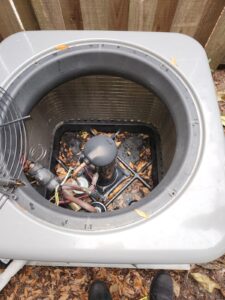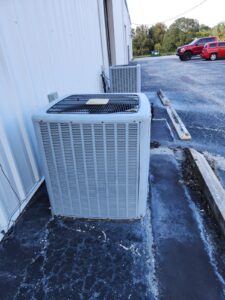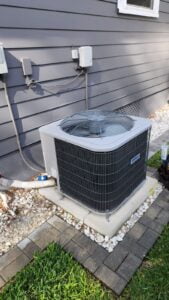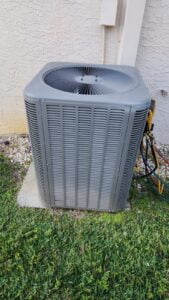3 Essential Facts About Condenser Coils and Compressors
In the realm of modern living, the comfort of our indoor environments is largely governed by the efficiency and effectiveness of Heating, Ventilation, and Air Conditioning (HVAC) systems. These systems are more than just luxury amenities; they are essential components that contribute to the overall quality of life by providing thermal comfort and acceptable indoor air quality. Central to the operation of these systems are two critical components: the condenser coils and the compressors. Their role is paramount in ensuring that our homes and workplaces remain havens of comfort regardless of the weather outside.
An HVAC system operates by manipulating the air temperature and quality within a space. It typically consists of an outdoor unit, which houses the condenser coil and compressor, and an indoor unit, which includes the evaporator coil and air handling components. The process of heating or cooling air involves a complex interplay of these components, where the compressor and condenser coil play pivotal roles in the refrigeration cycle.
The compressor, often called the “heart” of the air conditioning system, is responsible for circulating refrigerant throughout the system. It compresses the refrigerant gas, raising its pressure and temperature, and pumps it towards the condenser coil. Here, the condenser coil, acting as the “lungs” of the system, comes into play. It facilitates the transfer of heat from the refrigerant to the outside air. This process cools the refrigerant, which then travels back indoors to absorb more heat from the indoor air, thus continuing the cycle.
The efficiency of an HVAC system is heavily reliant on the proper functioning of the condenser coils and compressor. Any issues with these components can lead to decreased efficiency, higher energy costs, and potentially costly repairs. Regular maintenance of these parts is not just recommended; it is crucial for the longevity and effectiveness of the entire system. Understanding the importance and functionality of condenser coils and compressors is the first step in appreciating and maintaining the complex system that keeps our indoor environments comfortable year-round.
What are Condenser Coils and Compressors?
To fully grasp the functionality of an HVAC system, it’s essential to understand the roles of its core components: the condenser coils and the compressor. These elements are integral to the refrigeration cycle, which is the process that removes heat from indoor air and releases it outside, thereby cooling your home or office.
Compressor: The Heart of the HVAC System
The compressor is often described as the heart of the air conditioning system. Its primary function is to circulate refrigerant, the substance vital for heat exchange, throughout the system. Located in the outdoor unit of the HVAC system, the compressor has several key responsibilities:
- Compression of Refrigerant: The compressor takes in low-pressure, low-temperature refrigerant gas and compresses it into a high-pressure, high-temperature gas. This process is crucial because it prepares the refrigerant for the heat release phase.
- Circulation of Refrigerant: Once compressed, the refrigerant is pushed through the system. This movement is vital for the refrigeration cycle, allowing the refrigerant to absorb indoor heat and release it outdoors.
Condenser Coils: The Lungs of the HVAC System
The condenser coils often likened to the lungs of the system, play a crucial role in the heat exchange process. These coils are also located in the outdoor unit and work directly with the compressor. Their primary functions include:
- Heat Dissipation: When the high-pressure, high-temperature refrigerant gas reaches the condenser coils, it is exposed to the outdoor air. The coils facilitate the transfer of heat from the refrigerant to the outside environment. This process cools the refrigerant, which then transforms from a gas into a liquid.
- Preparation for Indoor Cooling: Once the refrigerant has released its heat and turned it into a liquid, it is ready to be cycled back into the indoor unit. Here, it will absorb indoor heat, thereby cooling the air inside the building.

Types of Condenser Coils and Compressors
HVAC systems come in various configurations, each with different types of condenser coils and compressors. The choice of these components can affect the efficiency, cost, and maintenance requirements of the system. Understanding these variations helps in making informed decisions about HVAC installations and maintenance.
Types of Condenser Coils
- Tube-and-Fin Coils: One of the most common types, tube-and-fin condenser coils, consist of tubes that refrigerant flows through, surrounded by a series of metal fins that facilitate heat transfer. The fins increase the surface area available for heat exchange, making the process more efficient. These coils are typically made from copper tubing with aluminum fins.
- Spine Fin Coils: Spine fin coils use thousands of tiny spines attached to the tube surfaces, offering even greater surface area than traditional tube-and-fin designs. This increased surface area improves the heat exchange process, making spine fin coils more efficient. They are often more resistant to clogging and easier to clean but can be more susceptible to physical damage.
Types of Compressors
- Reciprocating Compressors: These compressors use pistons driven by a crankshaft to compress the refrigerant. They are commonly found in smaller systems and are known for their durability and ease of maintenance. However, they can be noisier and less efficient than other types.
- Scroll Compressors: Scroll compressors have two spiral-shaped scrolls; one remains stationary while the other orbits around it, compressing the refrigerant. They are known for their efficiency, quiet operation, and longer lifespan. Scroll compressors are widely used in residential HVAC systems.
- Screw Compressors: These compressors use two helical screws to compress the refrigerant. They are typically used in large commercial HVAC systems and are valued for their durability, efficiency, and capacity to handle large volumes of refrigerant.
- Centrifugal Compressors: Centrifugal compressors use a rapidly rotating impeller to transfer energy to the refrigerant, compressing it through centrifugal force. These compressors are generally used in very large HVAC systems, such as those in commercial or industrial settings, and are known for their smooth, vibration-free operation.
Facts About Condenser Coils and Compressors
As The AC Therapist, I’ve encountered numerous HVAC systems and understand the critical importance of two components: condenser coils and compressors. These elements are fundamental to the functionality and efficiency of any air conditioning system. Here are three essential facts about condenser coils and compressors that every homeowner and business owner should know:
- The Core of Cooling Efficiency: The condenser coils and compressors are at the heart of your HVAC system’s cooling process. The compressor’s job is to compress the refrigerant, which increases its temperature and pressure. This high-pressure gas then travels to the condenser coils, where it releases its heat to the outside air. This process is crucial because it transforms the refrigerant back into a liquid, which is essential for absorbing heat from your indoor air. Without properly functioning condenser coils and compressors, your system can’t efficiently cool your space.
- Maintenance is Key to Longevity: Regular maintenance of your condenser coils and compressors is not just about preventing breakdowns; it’s about extending the life of your HVAC system. Dirty or clogged condenser coils can lead to overheating and system failure, while issues with the compressor can result in a complete system shutdown. Simple actions like cleaning the coils, ensuring adequate airflow, and having regular professional check-ups can keep these components in top condition, thereby enhancing the overall longevity of your system.
- Early Signs of Trouble to Watch For Being aware of the early signs of trouble can save you from costly repairs down the line. If your system is not cooling as effectively as it used to, or if you hear unusual noises coming from the outdoor unit, it’s time to take a closer look at your condenser coils and compressor. Other warning signs include the system frequently turning on and off (short-cycling), ice formation on the coils, and an unexplained increase in your energy bills. Addressing these issues promptly can prevent more significant problems in the future.

Troubleshooting Common Issues
HVAC systems, like any mechanical system, can encounter various issues over time. Being able to identify common problems with condenser coils and compressors can help you address them promptly, either through DIY methods or by calling a professional. Here’s a guide to help you navigate these situations.
Identifying Common Problems
- Dirty Condenser Coils: If the coils are covered in dirt and debris, they can’t effectively release heat, leading to decreased efficiency and increased strain on the system. Signs include reduced cooling capacity and the system running longer than usual.
- Refrigerant Leaks: Leaks can occur in various parts of the HVAC system, including the coils and compressor. Symptoms include hissing noises, ice formation on the coils, and reduced cooling efficiency.
- Compressor Failure: The compressor may fail due to various reasons, such as electrical issues, refrigerant problems, or wear and tear. Indicators include strange noises (like clicking or buzzing), the system not cooling, or the compressor not starting.
DIY Troubleshooting Tips
- Cleaning Condenser Coils: Turn off the power to the unit, remove debris, and gently clean the coils with a soft brush and coil cleaner. Rinse carefully and allow to dry.
- Checking for Refrigerant Leaks: While you can look for signs of leaks (like oil residue or hissing sounds), handling refrigerant requires a professional due to its hazardous nature.
- Resetting the Compressor: Sometimes, simply resetting the system can resolve compressor issues. Turn off the power, wait for a few minutes, and then turn it back on.
When to Call a Professional
- Handling Refrigerant: Any issue involving refrigerant, such as recharging or repairing leaks, should be addressed by a certified technician due to safety and environmental concerns.
- Electrical Troubleshooting: If the problem seems to be electrical (e.g., the compressor not starting, frequent tripping of circuit breakers), it’s safer to call a professional.
- Complex System Issues: If the troubleshooting steps don’t resolve the problem, or if the issue is beyond your understanding, it’s time to call an HVAC professional. This is especially true for suspected compressor failure, which often requires specialized knowledge and tools.

Energy Efficiency and Performance
The efficiency and performance of an HVAC system are significantly influenced by the condition of its condenser coils and compressors. Well-maintained condenser coils and compressors not only enhance the system’s efficiency but also contribute to its overall longevity. Understanding how these components impact energy efficiency and system performance is crucial for homeowners and facility managers alike.
Improving Efficiency with Well-Maintained Condenser Coils and Compressors
The role of condenser coils and compressors in an HVAC system cannot be overstated. When condenser coils and compressors are kept in optimal condition, they operate more efficiently. Clean and well-functioning condenser coils ensure effective heat transfer, which is essential for cooling. Similarly, a well-maintained compressor efficiently compresses and circulates the refrigerant, crucial for the refrigeration cycle. When both condenser coils and compressors are in top shape, the system doesn’t have to work as hard to maintain the desired temperature, leading to increased energy efficiency.
Impact on Energy Bills
The efficiency of condenser coils and compressors directly affects energy consumption. If either the condenser coils or the compressors are not functioning properly, the system uses more energy to achieve the same level of cooling or heating. This increased energy usage is reflected in higher energy bills. Regular maintenance of condenser coils and compressors can prevent this unnecessary energy expenditure, ensuring that the system operates as efficiently as possible and keeps energy costs in check.
Contributing to System Longevity
The lifespan of an HVAC system is closely tied to the health of its condenser coils and compressors. When condenser coils and compressors are well-maintained, they experience less wear and tear, reducing the likelihood of premature failure. Regular cleaning of condenser coils and proper care of compressors can prevent common issues such as overheating, excessive pressure, and mechanical failure. By investing in the maintenance of condenser coils and compressors, you’re not only improving efficiency but also extending the life of the entire HVAC system.
Innovations and Future Trends
The HVAC industry is continuously evolving, with significant advancements in coil and compressor technology shaping the future of heating and cooling systems. These innovations are focused on enhancing efficiency, reducing environmental impact, and improving overall system performance. Understanding these advancements and future trends is crucial for staying ahead in the HVAC field.
Recent Advancements in Coil and Compressor Technology
- Smart Compressors: Modern compressors are increasingly incorporating smart technology, allowing for better control and optimization of performance. These smart compressors can adjust their operation based on real-time data, leading to improved efficiency and reduced energy consumption.
- Variable Speed Compressors: Unlike traditional compressors that operate at a constant speed, variable speed compressors can adjust their speed to match the cooling demand. This results in significant energy savings and a more consistent indoor temperature.
- Advanced Coil Materials: The development of new materials for condenser coils has led to improved heat transfer efficiency and corrosion resistance. For example, coils made from aluminum or coated with special anti-corrosive materials extend the life of the system and maintain efficiency over time.
- Eco-Friendly Refrigerants: With growing environmental concerns, there is a shift towards the use of refrigerants with lower Global Warming Potential (GWP). These new refrigerants are designed to be more efficient and have a reduced impact on the environment.
Future Trends in HVAC Systems
- Integration with Renewable Energy: Future HVAC systems are expected to integrate more seamlessly with renewable energy sources, such as solar power. This integration will further reduce the carbon footprint of heating and cooling systems.
- Smart HVAC Controls: The use of AI and IoT in HVAC systems is on the rise. These technologies allow for smarter, more efficient control of heating and cooling, often remotely through smartphones or other devices.
- Personalized Comfort Solutions: Future HVAC systems will likely focus on providing personalized comfort, with the ability to adjust settings for individual rooms or zones within a building. This will enhance comfort while optimizing energy usage.
- Sustainability and Green Building Practices: As sustainability becomes a more pressing concern, HVAC systems will continue to evolve to meet green building standards. This includes not only energy efficiency but also the use of sustainable materials and practices in manufacturing and installation.

Innovations and Future Trends
The HVAC industry is witnessing a remarkable evolution, particularly in the areas of condenser coils and compressors. These advancements in condenser coils and compressor technology are not only enhancing system efficiency but also shaping the future trends in HVAC systems. Let’s delve into the recent innovations in condenser coils and compressors and explore the emerging trends in HVAC systems.
Recent Advancements in Condenser Coils and Compressor Technology
- High-Efficiency Condenser Coils: The development of more efficient condenser coils has been a significant focus. Newer condenser coils feature advanced designs and materials that improve heat transfer efficiency and reduce energy consumption.
- Smart Compressors: The integration of smart technology into compressors marks a significant advancement. These smart compressors, equipped with sensors and advanced control systems, can optimize the operation of condenser coils and compressors, leading to enhanced system efficiency and performance.
- Variable Speed Compressors: A major leap in compressor technology is the adoption of variable speed compressors. Unlike traditional compressors, these can adjust their speed to match the cooling demand, working in tandem with condenser coils for optimal efficiency.
- Eco-Friendly Refrigerants: The shift towards eco-friendly refrigerants in condenser coils and compressors is a notable advancement. These new refrigerants are compatible with modern condenser coils and compressors, offering lower environmental impact without compromising efficiency.
Future Trends in HVAC Systems Involving Condenser Coils and Compressors
- Sustainable Condenser Coils and Compressors: The future of HVAC is leaning towards sustainability, with condenser coils and compressors being designed to minimize environmental impact while maximizing efficiency.
- Integration with Renewable Energy: Future HVAC systems, including their condenser coils and compressors, are expected to integrate more seamlessly with renewable energy sources. This integration will enhance the sustainability of condenser coils and compressors.
- Advanced Diagnostics for Condenser Coils and Compressors: Advanced diagnostic tools and predictive maintenance for condenser coils and compressors are set to become a standard practice, ensuring optimal performance and longevity.
- Customizable and Modular Systems: The future will see more customizable HVAC systems, where condenser coils and compressors can be tailored to specific needs and environments, offering flexibility and improved efficiency.
Insights from The AC Therapist
As The AC Therapist, I’ve seen firsthand how the health of your HVAC system hinges on the well-being of its condenser coils and compressors. These components are the unsung heroes of your air conditioning system, tirelessly working to keep your spaces comfortable and cool. Through this blog, I aimed to shed light on the crucial roles of condenser coils and compressors, their maintenance, and the common issues they face.
Remember, regular maintenance of your condenser coils and compressors is not just a recommendation; it’s a necessity. It ensures that your system runs efficiently, saves you money on energy bills, and extends the lifespan of your HVAC unit. Whether you’re a homeowner, a business owner, or just someone curious about how your AC works, I hope these insights empower you to take better care of your system.
At The AC Therapist, we’re committed to providing you with the knowledge and services to maintain your HVAC system at its best. If you ever find yourself in need of professional advice or assistance with your condenser coils and compressors, don’t hesitate to reach out. We’re here to help you keep your cool, one HVAC system at a time.








